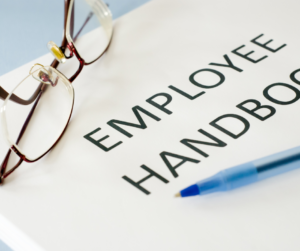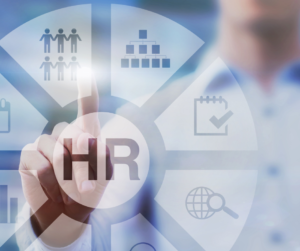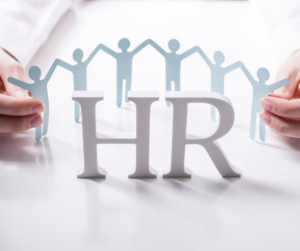
by admin | Feb 13, 2023 | Human Resources
 There aren’t rules for how frequently you should update your handbook, but given laws do change, it’s smart to be proactive so you don’t get caught off guard.
There aren’t rules for how frequently you should update your handbook, but given laws do change, it’s smart to be proactive so you don’t get caught off guard.
An updated employee handbook helps employees understand what’s expected of them, and helps managers ensure company policies are followed.
We’ve identified four reasons to revisit your employee handbook in 2023.
New year, new employee handbook? There aren’t any hard and fast rules that require your handbook to be updated at specific intervals. But instead of assuming it’ll get you through 2023, there are good reasons to treat it like the living document it is.
First, the implementation of updated, clear policies that both employees can understand, and managers apply consistently will help employees feel like they’re being treated fairly.
Next, having a handbook that you know is up to date with current laws (and well understood by managers) can help reduce the likelihood of a claim against your business. Plus, if an employee or former employee does file a claim, a handbook can provide valuable documentation to demonstrate that your business has equitable and compliant workplace policies in place.
Here are 4 policies we think you should pay attention to in 2023:
- Personal Appearance/Grooming (CROWN Acts): Employers with dress codes or appearance policies need to keep an eye out for CROWN Acts, as these laws generally protect traits associated with race, including natural and protective hairstyles. If you have policies that prohibit afros, dreadlocks (a.k.a. locks), or hair past a certain length, they’ll need to be revisited. Even if you aren’t subject to a law that protects natural hairstyles, we recommend removing restrictions that are more likely to affect employees of a particular race, sex, or religion, in order to increase inclusivity.
- EEO (for CROWN acts and many others): Equal Employment Opportunity policies generally list the classes or characteristics that are protected by federal and state law. We see a handful of new state-level protections every year, so employers (especially those operating in multiple states) need to ensure that their EEO policies are up to date.It’s common for employee handbooks to say that they won’t discriminate based on the federally protected classes, and then say, “and any other class protected by state or federal law”. This catch-all is a nice idea, but many employers aren’t aware of all the classes that are protected by federal and state law. As a result, they can be caught off guard – and in a lawsuit – because they simply didn’t know the actions they were taking were considered illegal discrimination.That’s why we recommend including the full list of protected classes in the employee handbook. More knowledge is better. Also, managers have a duty to ensure that employees aren’t harassing one another based on their inclusion in a protected class. And if your managers aren’t aware of the full extent of their responsibilities, they’re going to have a much harder time keeping your workplace in compliance.
- Sick leave policies: State sick leave laws were trending even before the pandemic and that hasn’t let up. Even when we’re not getting brand-new laws, we’re seeing expansions of the existing requirements to cover more situations. Given employees’ heightened awareness of how disease spreads and an increased desire to avoid illness, we recommend revisiting your sick leave policies — even if they aren’t required by law – to ensure that employees are encouraged to stay home when sick.
- State Family and Medical Leave: State family leaves, whether paid or unpaid, are being passed at a steady clip. These usually interact with FMLA as well as benefits offered by the company, so it’s appropriate for employers to have this laid out in their handbook so that both managers and employees know when these leaves apply.
Taking steps to ensure your employee handbook reflects today’s workplace just makes sense. Your company isn’t stagnant, and the regulatory environment in which it operates certainly isn’t standing still. So, whether you review it annually, every six months, or quarterly, be proactive about updating your employee handbook in 2023. You’ll be glad you did.
Originally posted on Mineral

by admin | Jan 16, 2023 | Hot Topics, Human Resources
 The new year is on the horizon, and everyone is predicting what 2023 HR trends to anticipate. Recently, HR Exchange Network posted a question on Terkel.io to discover what Human Resources and business leaders will be navigating, challenging, and experiencing in the year ahead. Here are the answers:
The new year is on the horizon, and everyone is predicting what 2023 HR trends to anticipate. Recently, HR Exchange Network posted a question on Terkel.io to discover what Human Resources and business leaders will be navigating, challenging, and experiencing in the year ahead. Here are the answers:
Bring It with Gamification
“Gamification is one of the biggest HR trends of 2023. It’s the use of game-like elements in non-game contexts, such as using points, badges, and leaderboards to encourage employees to achieve their goals. Gamification can also be used to engage employees in learning new skills or knowledge. There are many ways to gamify your HR program, but one of the most important things to keep in mind is that you need to make sure the games you create are fun and challenging.” -Antreas Koutis, Administrative Manager, Financer
Become the Great Communicator
“Many employers face an uncertain future in 2023. Rising inflation, utilities prices, and the possibility of economic recessions are all combining to introduce doubt about the next 12 months. One of the biggest questions for HR and senior leaders is going to be what they do on staff pay in response. Raise salaries to keep people afloat or hold back because the possibility of a recession may erode profitability? For those companies who can’t raise salaries to match inflation, benefits are going to become even more important.
Crucially though, employers may not need to introduce new benefits, just to communicate better about existing ones…2023 may be the year that HR seeks to make benefits communications louder through a multichannel communications strategy that reaches every worker, no matter where they are.” -Scott Hitchins, CMO, Interact Software
Meet in the Metaverse
“The biggest HR trend is Metaverse. According to Gartner, 25% of people will spend at least one hour daily in the metaverse by 2026. This suggests that some of these initiatives, such as virtual events, employee onboarding, career fairs, and meetings, will be launched by the biggest companies in this field in 2023. The metaverse makes it possible to reimagine a creative, collaborative, and productive world without being restricted by physical conventions.
The small number of companies that have begun to take advantage of the metaverse’s possibilities will have more modern employer brands, more exciting interactions with remote applicants, and even be able to increase productivity. To employ technology effectively, our HR ensures healthy metaverse working procedures by creating new hybrid working policies and training leaders through sessions on how to lead in this unique, upcoming setting.” -Shaun Connell, Founder, Writing Tips Institute
Put Out the Fire to End Burnout
“One of the biggest HR trends of 2023 will be the initiatives to counter or avoid employee burnout. Employee wellness will be emphasized more because it’s one of the factors that applicants prioritize when looking for a job. If you want to hire quality talent, you must attract them with quality compensation, which is why wellness programs that prioritize employee health, happiness, and contentment will be a big deal in the future.
To prepare for this, we have already slowly implemented a few programs. A part of our employee benefits includes a health care plan that encompasses mental health services. They may not be open to seeking help from peers and their manager, but at least you made it known that you have provided it for their use at any time in case they need counseling and therapy.” -Debbie Meeuws, Owner and CEO, Nature’s Arc Organic
Get Your People to Stay
“I think one of the biggest HR trends of 2023 will be a focus on employee retention. With the economy slowly recovering from the pandemic, companies will be more worried about losing their top talent to competitors. Companies will increasingly recognize that it is more cost-effective to invest in retaining existing employees than to constantly recruit and train new ones.
They’ll therefore invest more in employee development and engagement programs. I’m preparing for this trend by ensuring that our HR policies and practices are aligned with our company’s strategy and goals. We’ll also need to focus on creating a positive work environment and offering competitive benefits packages.” -Johannes Larsson, Founder and CEO, JohannesLarsson.com
Make It the Year of Flexibility
“One of the biggest HR trends of 2023 will be the continued rise of remote work. With more and more companies embracing flexible work arrangements, it’s likely that even more employees will be working from home in the next few years. To prepare for this trend, my HR team and I are focusing on creating policies and procedures that will make it easy for employees to work remotely. We’re also working on ensuring that our communication and collaboration tools are up to date so that everyone can stay connected no matter where they are.” -Erik Pham, CEO, Health Canal
Invest in Self-Care
“A subtle problem is affecting organizations. According to the American Psychological Association (APA), the pandemic’s effects on workplace stress were felt by more than three out of five employees. Eighty-seven percent of Americans are concerned about inflation, and seven in 10 workers are worried that their income hasn’t grown to reflect increases in purchasing power. In order to address the burnout dilemma, HR must first address its own.
Even though it may go against the basic requirement of their profession to prioritize helping others, human resources specialists should put on their own oxygen masks first. If not, the department won’t have the resources to help the rest of the business. The next thing we expect HR to do is to take a more proactive approach to resilience and well-being. This requires developing a more comprehensive employee welfare strategy that gives priority to their financial, physical, and mental well-being.” -Brad Burnie, Founder, Starships
Promote from Within
“One potential HR trend in 2023 is the prioritization of internal mobility to boost employee morale and foster career development. Companies will invest in reskilling and upskilling their existing employees to prepare them for more extensive and technical roles. Doing so will allow these employees to progress in their chosen fields, which equates to team growth and professional satisfaction.
As early as now, we’re slowly diverting our efforts to internal mobility, which financially benefits our company and accelerates our recruitment process. Since we no longer need to outsource talents, we can focus more on our current employees, allowing us to assess better who deserves to get promoted based on their running performances. It also lets us save on future financial expenses, as spending to retain existing talents is more budget-friendly than acquiring new ones.” -Sam Tabak, Board Member, RMBH Charities
Be More Transparent about Pay
“Given the new laws that have gone into effect recently (New York’s Pay Transparency and Colorado’s Equal Pay) along with the new laws going into effect in Washington and California, keeping pay behind closed doors is going to become increasingly difficult. There are many different approaches to this, but I am in favor of first making sure all employees within the company are within the band and then making all bands public. While it may be a bit radical, I’ll tell you why.
First, it increases transparency and equitability for your employee population, which I’ve seen often results in more buy-in than less. Second, it wastes less time for the company and candidates during the recruiting process. Lastly, attracting more talent within range, which long-term is better ROI. While this sort of transparency can be very hard for companies, in my experience it’s a ton harder to deal with the potential ramifications of not posting them, both from a compliance perspective and as a talent retention tool.” -Cheyenne Horvat, Manager, People Ops, Carta
Rely More on Advanced HR Tech
“Algorithmic HR is already gaining ground in the gig economy. Experts are anticipating that by 2023, the majority of HR departments across the industry will start relying on it as well for HR management. The prediction is there will be vast incorporation of AI for HR functions such as hiring and firing candidates, growing the candidate pool, and facilitating employee engagement in the workplace.
In our company, we’re preparing to incorporate algorithmic HR in our operations by slowly integrating AI and machine learning into our recruitment process. We’re conducting A/B testing to find the best AI tools that work best for us. We want to take ownership of this new system so that we can ensure that there is fairness and inclusion in this process.” -Stacie Tyler, CFO, Walk Big Media
By Francesca Di Meglio
Originally posted on HR Exchange Network

by admin | Jan 5, 2023 | Human Resources
 Empathy in Human Resources Management is something that comes up often. The idea of a stern leader, who rules with an iron fist, is outdated. Today’s leaders are expected to build relationships and trust to ensure they get the most out of employees. HR has the double burden of demonstrating empathy and teaching executives to model this kind of behavior. Rarely, however, does anyone dissect what it means to be an empathetic leader.
Empathy in Human Resources Management is something that comes up often. The idea of a stern leader, who rules with an iron fist, is outdated. Today’s leaders are expected to build relationships and trust to ensure they get the most out of employees. HR has the double burden of demonstrating empathy and teaching executives to model this kind of behavior. Rarely, however, does anyone dissect what it means to be an empathetic leader.
Define Empathy
Empathy is defined as the ability to understand and share feelings of another. When it comes to leadership, it means to care for employees and consider their feelings. Lots of research points to the fact that empathetic leaders help lead teams to better business results, according to Forbes.
For example, Catalyst found that those with empathetic leaders are more productive and innovative. They burn out less often. They foster inclusion. Most importantly, they are less likely to leave their employers. All this is proven to give an edge to companies. After all, these factors lead to better business outcomes.
How to Be Empathetic
To be an empathetic leader is about finding one’s humanity and acting upon it. Some of it may seem obvious. Trying to understand what others are going through and facing is a great place to start. In this time of divisiveness, when leaders’ earnings are further apart from workers than ever before, this idea of relating to one another becomes paramount. Communication is a big part of this style of leadership. Here are some other best practices when striving to have empathy:
Ask people how they are doing and actively listen.
In other words, pay attention to what they say, and repeat it to ensure you understand them. Learn to stay quiet and let people share their thoughts and feelings. Then, follow up with appropriate questions. When necessary, offer ideas for problem solving or simply comfort the person. The time when people could not cry at the office are over.
Respond to the employees’ unique needs.
Part of the new leader’s goal is to develop relationships with employees. Once managers do so and understand how each person feels and what motivates them, they can take action. This could mean providing flexibility to a working mom, who is trying to do it all or providing personalized employee benefits. Perhaps, it means providing the right bonus or gift to encourage retention.
Get comfortable with feelings.
Even before the pandemic, eight in 10 people had said they cried at work, according to Monster.com and reported by various news outlets, including CNN. More than 44% of C-suite executives said crying at work is okay from time to time, and another 30% said it has no negative effect on how one is perceived at work, according to Robert Half Talent Solutions and as reported by Harvard Business Review. Emotions are running high in this post-COVID era, so people need to be comfortable with the various ways people may be feeling.
Some employees – not to mention managers – could be sad, angry, frustrated, stressed, and so on. Being more open and transparent about human feelings will make others more comfortable. It will help shed stigma, too. Obviously, if people are overly emotional, then colleagues and managers should provide them with resources and access to help with mental health and wellness. But no one should expect managers or HR professionals to serve as psychologists or even counselors. It is simply a matter of being comfortable in one’s skin.
Check in regularly. At the start of each meeting, find out what’s happening in the life of employees. The response might be about the anxiety of completing a big project, for example. Or it can simply be about what everyone has done over the weekend. By making it a habit to start meetings with this personal catch up time, empathetic leaders are building a forum for people to come to them with problems or concerns. When managers and HR professionals see signs of burnout or mental illness, then they should direct people to the appropriate help.
By Francesca Di Meglio
Originally posted on HR Exchange Network

by admin | Dec 26, 2022 | Human Resources
 The pandemic and job market have made it difficult for employers to attract and retain talent, negatively impacting operations and profitability.
The pandemic and job market have made it difficult for employers to attract and retain talent, negatively impacting operations and profitability.- Mineral’s Healthy HR framework shows you what companies with high productivity, morale, and engagement have in common.
- The Healthy HR framework is built on performing well on all four of the following pillars: thoughtful compensation and benefits, good work-life balance, the potential for career growth, and appropriate workload.
- On average, 70% of organizations are researching competitors and looking to improve their compensation packages to attract and keep talent.
These past few years have been anything but “business as usual.” From lockdowns to resignations, new variants and economic uncertainty, companies have been forced to navigate these challenges with no roadmap. While companies had to take their own path, some have faded, others survived, and a few – interestingly – even thrived.
But could account for these differences in outcome? We wanted to do a deep dive to find out.
In February 2022, Mineral surveyed 2,644 senior HR professionals in the United States. We sought to uncover what businesses with high performance during the pandemic had in common with respect to what their HR departments chose to prioritize. Our study indicates that revenue and productivity gains are tied to employee morale. How well a company treats its employees corresponds to its ability to attain business growth. We translated our data into a framework to help businesses like yours unlock the connection between strong employee morale and increased revenue and productivity. We call this framework Healthy HR.
The Healthy HR Framework
Companies that grew in both revenue and productivity had four things in common. These four indicators, which are all tied to employee morale, make up what we call Healthy HR. These indicators are:
- Thoughtful compensation
- Good work-life balance
- Potential for career growth
- Appropriate workload
Based on how well organizations perform in these areas, they are rated as either Weak, Average, or Strong. Weak organizations do not perform well in any category, while Strong businesses do well in all four. Our results found, unsurprisingly, that Strong organizations are most likely to succeed in increasing productivity and revenue even when faced with macro-environment challenges.
But the amount of business value Strong organizations received did may surprise you! Strong organizations saw real, impactful improvements to their bottom line – and in more places than just the bottom line. Our study found that 68% of Strong performers saw an increase in employee morale, despite the challenges of the pandemic. Weak organizations, on the other hand, identified a 13% decrease in employee morale.
Healthy HR doesn’t just happen, however. It requires a culture of investment in HR and proactive efforts.
Here is what our State of HR survey found on how Strong companies perform in the Thoughtful Compensation and Benefits category and how you can imitate their success.
How Strong Healthy HR Companies Package Thoughtful Compensation & Benefits
Pay has always been one of the most important factors for employees. However, salary isn’t the only component of compensation. Health benefits, paid time off, and bonuses also make up the total compensation package. But how are strong Healthy HR companies adjusting their compensation and benefits packages?
We found that roughly 60% of small organizations offer flexible remote and hybrid work options and proactively review market wages to update their compensation. This small business movement is mirrored by over 75% of large organizations doing the same.
Strong companies are broadly putting efforts toward meeting their employees’ compensation and benefits expectations. Our survey found that:
- 76% proactively review market wages and update internal targets
- 75% consider employee quality of life during compensation decisions
- 73% offer very flexible working hours with all employees
- 70% offer flexible remote and hybrid work options
- 64% tailor benefits packages to specific employee situations
Strong Healthy HR organizations are more than 10 times more likely to tailor benefits to specific employee situations than weak organizations. This can include offering adjusted working hours to accommodate family needs or providing additional time off to employees that need it. Employers in this job-seekers market are adjusting to their compensation practices. Is yours keeping pace?
What Your Organization Should Do
Not every organization is able to increase employee compensation or provide new benefits. Sometimes there are budget limitations. At other times, recruiting and staffing could be pain points that limit growth. Further, not every company can take advantage of every benefit (some organizations, like services and restaurants, always require in-house staff). However, proactive steps toward Healthy HR can begin even with small steps.
Whether you’re a growing organization with little to no funds available to alter your compensation or benefits, or need outside the box thinking, here are some ways to enhance your compensation practices:
- Be aware of trending benefits for both your employees, location, and industry
- Consider polling employees on the type of benefits that interest them
- Offer one unique benefit that ties in with your culture and values
- Examples include stipends to support small businesses, allow bereavement periods for the loss of a pet, charge accounts for snacks or coffee at employees’ favorite gas stations, recess time, blue light lens glasses, game tickets, or vouchers for spas and massages
- Establish guidelines around how and when the company discusses pay and benefits with job candidates and employees
- Track utilization rates of your current offered benefits
Another key aspect for helping organizations improve in Healthy HR: focusing on mental health. We found in our research that every Strong organization placed a heightened focus on employees’ mental health. Strong posture companies were 11x more likely to prioritize this and tried to support it through the pillars of Healthy HR – including thoughtful compensation and benefits. From fostering a culture around wellness (71%) to revising procedures to empower managers and supervisors to check in (68%), promoting mental wellness through the compensation pillar could hold the key to elevating your organization’s Healthy HR standing.
The job market and pandemic have forced many companies into a reactive posture. But organizations with Healthy HR showcased their resilience, agility, and endurance. As it’s always a matter of when – not if – the next crisis will impact your organization, our research has revealed that a surefire way to withstand it is by proactively investing in Healthy HR.
By Alexander Lahargoue
Originally posted on Mineral

by admin | Dec 15, 2022 | Human Resources
 Learning and development is a necessary part of life, and it is required for mobility and succession planning at work. Yet, many HR departments fail to implement a complete L&D strategy or they do not even know where to begin.
Learning and development is a necessary part of life, and it is required for mobility and succession planning at work. Yet, many HR departments fail to implement a complete L&D strategy or they do not even know where to begin.
The good news is that most leaders have great intentions. Of the respondents to the 2021 State of HR survey, 35% said they wanted to improve culture by transforming training and development efforts. At the Corporate Learning EMEA online event, which is free to join, viewers can gain insight into how to develop an adaptive and skilled workforce.
Find out about the five lessons to learn about learning and development:
An Honest Education
Erika Ullmann, Director, Learning & Development at Virgin Media – Ireland, recognizes the power of transparency in today’s workforce. She plans to take that message to the audience when she kicks off the Corporate Learning EMEA event in a fireside chat. Still, the highlight of the session will likely be a conversation about applying virtual reality to leadership training.
Getting Personal
Digital Adoption Expert at Whatfix, Pretyush Shama, plans to speak about how to personalize education and measure performance, which is frankly vital to prioritizing L&D and getting leadership buy in. In this session, Shama will explain how software can help employers offer customized learning and an ability to measure the effectiveness of the training.
Get Organized
One of the biggest challenges facing learning and development leaders is offering a streamlined curriculum that is easy to access and features all the necessary content to catapult learners into the future. In a session with Toby Harris, Chief Marketing Officer at filtered, the audience will learn about how to assess solutions and prioritize skillsets and knowledge areas.
Understand the Ecosystem
Discover how to build a learning ecosystem, which is essentially everything related to a company’s training and development efforts. This lesson, courtesy of Francesco Mantovani, Director, Global Learning Technologies and Innovation at Procter & Gamble, promises to share insight on the ecosystem by sharing the lessons he learned from making mistakes along the way.
Use Data
A mistake that many HR leaders make is to plan learning and development coursework and then, perhaps, look at data. Instead, Jonathan Kettleborough, Senior Lecturer, Information Systems Strategy at Manchester Metropolitan University, plans to divulge the ways to use data to determine what employees should study and demonstrate value to leaders.
Although these leaders are based in Europe, the lessons they have to share are relevant to all HR and learning and development leaders. Their experiences can help leaders determine learning content, delivery, and culture.
By Francesca Di Meglio
Originally posted on HR Exchange Network

by admin | Dec 6, 2022 | Human Resources
 Employee engagement and experience is at the core of what most Human Resources professionals do on a daily basis. From hiring to succession planning, HR is first and foremost focused on recruiting and retaining top talent. Keeping those talented people engaged in their work is key to achieving positive business outcomes.
Employee engagement and experience is at the core of what most Human Resources professionals do on a daily basis. From hiring to succession planning, HR is first and foremost focused on recruiting and retaining top talent. Keeping those talented people engaged in their work is key to achieving positive business outcomes.
Recently, speakers at the 2022 HR Exchange Network Employee Engagement and Experience online event shared their best advice, telling lessons, and hard-won battle stories. Discover the most unforgettable quote on employee engagement and experience from each session:
Putting Belonging in DEI
“What belonging means for us is how you make people feel included, valued. How proud do they feel being part of our brand? How connected are we regardless of where we are and how safe we feel working in this organization.” –Gayatheri Silvakumer, Chief HR and Talent Officer, APAC, McCann Worldgroup
What’s Next in Employee Experience?
“We’re building in the mobile application – push notifications that say, ‘Have you thought about this role?’ We look at potential lateral moves for skillsets. It sends reminders, bits of news. We’re sharing our commitment to ESG with people.”-Graeme Poules, People Director, Employee Experience and Operations, Bupa
Cloud Solutions for Efficiency in Employee Engagement
“Newer cloud solutions are much easier to integrate, so you can choose a strategy where you’ll be implementing the best solution for the best purpose. It’s much easier in the cloud than on premises, for sure.”-Frederik Skyggebjerg, Head of Solution Consulting for APAC at Unit4
Employee Engagement Is Change Management
“What transformation really does is put a lot of strain on engagement. It is a fact. This is not unfamiliar to all of us. But an HR leader like me, who is experiencing this, there are employees who are feeling overwhelmed, confused, sometimes disconnected, angry. I would also like to highlight the fact that with COVID, all that the world has faced over the past couple of years, the threshold for the employee to take stress has really gone down. There are a lot of studies available that fatigue sets in much faster. Coupled with transformation, it hits employees. Could the Great Resignation be happening because there is continuous change?” –Trupti Mohan, Vice President HR Asia-Pacific, Fresenius Medical Care
Add the Joy
“I really, really believe the future of work should be purpose-led and fun. I don’t think it should be a chore, where people wake up on a Monday morning dreading it. It should be something they’re really excited about as well.”-Sharenya S. Kumar, former General Manager Employee Experience, Crown Resorts
Equip HR Teams for Success with a Digital-First Approach
“Digital-first means we can be more inclusive and intentional on how we work. It lets us stay focused on great outcomes…Everyone may be remote, working in different places and time zones, yet communication and collaboration are the lifeblood of any successful company.”-Meiyea Neo, HR Director, Zendesk
Know the Difference Between GBS and Shared Services
“[Global Business Services] is more integrated. It’s an advanced version of the shared service model. It’s evolved from new demands that have come up as the world has gotten more global and organizations have gotten more global. It’s truly a more global model. Shared services can be more regional, country-based, or multinational based.”-Eithne Freeney, Employee Experience Sales Manager ANZ, ServiceNow
Importance of Recognition
“When I feel validated at work, I can take my hand and tap my shoulder and say, ‘I added value today,’ because I belong to an organization that is creating the most amazing change in the workforce. Having that belonging and having that understanding of where you are in the workforce is really the heart-centered way of how an organization operates. That is what people are saying and asking for in our organizations.” –Shereen Williams, Director People and Culture Technology & Innovation at Standard Chartered
Slow and Steady Wins
“I can’t stress this enough, and I’m sure I have many allies in the HR community, who may be on this call and may have influenced stakeholders, that any focus on culture and engagement takes time. You really need to focus and chip away if you’re going to see a consistent change.” –David Monti, Senior Manager Culture and Engagement, Transport for NSW
Look Within for Strength
“As we all know, the competition for talent is fiercer than ever, post COVID-19. So, the talent you’re looking for is likely already in your organization. It’s just a case of finding it by aligning the skills of your integral workforce to the work required rather than aligning the individual to the problem.” –Chris Broadway, Technology Sales Manager, PeopleScout
By Francesca Di Meglio
Originally posted on HR Exchange Network






